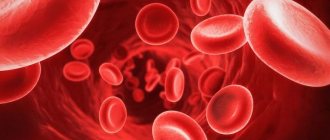ESR is one of the important and mandatory laboratory indicators of a clinical blood test. During pathological processes in the body, the ESR value changes, which helps to determine the type of pathology and make the correct diagnosis. The acceptable digital value for men and women is slightly different. In this article we will look at the ESR norm for women over 40 years old, as well as the reasons why this indicator may change.
Now let's look at this in more detail.
What is erythrocyte sedimentation rate?
Erythrocytes, or red blood elements, have a higher specific gravity than the organic mass called blood plasma. In the bloodstream, all these components constantly move, so the blood looks like a homogeneous substance. At rest (in a test tube), red cells begin to gradually fall to the bottom of the container.
In the blood of a healthy person, the sedimentation of erythrocytes is a smooth process, but with pathologies and intoxications, the rate of precipitation of red elements noticeably increases.
ESR is measured in millimeters per hour (mm/h), as it is determined by the height of the plasma column exfoliated from the red blood cells in a test tube for 1 hour.
Purpose of analysis
Blood tests are of great importance in medicine. They help establish the correct diagnosis and monitor the effectiveness of treatment. Situations when ESR in the blood is elevated are quite common in medical practice. This is not a reason to panic, because there are many reasons for changes in the erythrocyte sedimentation rate. The test indicates possible health problems and is considered a reason to conduct additional research.
The result of an ESR study gives the doctor a lot of useful information:
- Serves as the basis for timely medical research (blood biochemistry, ultrasound examination, biopsy, etc.)
- As part of the diagnostic complex, it makes it possible to objectively judge the patient’s health and establish a diagnosis
- ESR readings over time help monitor the effectiveness of treatment and confirm the correctness of the diagnosis.
What does increased ESR in the blood mean?
Since the study of this interesting pattern, reference - standard - indicators of ESR in the blood have been identified and approved. They were determined as a result of many years of observation of healthy and unhealthy people.
In healthy people, the ESR level is approximately the same and does not exceed 15-20 mm/h.
If the test result shows higher numbers, this means that the ESR value in the blood is increased.
The mechanism for accelerating the shedding of red cells is due to the appearance in the plasma of a large amount of proteins formed during infectious and inflammatory processes. They adhere to red blood cells, which leads to their adhesion and the formation of conglomerates (“columns”) of them. Adhesion is observed in a large number of diseases, but its main feature is that it accelerates the fall of red blood cells under the influence of the Earth’s gravitational field. Simply put, red blood cells stuck together are more quickly attracted by gravity to the bottom of the test tube.
Erythrocyte sedimentation after an hour
Rules for taking a blood test
Today, the ESR level is determined automatically. Laboratory equipment gives the most accurate results and allows you to avoid medical errors when calculating the indicator. ESR also depends on the conditions of blood sampling for analysis:
- Blood from a vein should be donated on an empty stomach. Eating 8 hours before visiting the laboratory. The day before, it is forbidden to consume spicy/fatty foods, soda, or fast food. A heavy dinner leads to an increased ESR in a woman’s blood.
- You are allowed to drink some water 3 hours before the test.
- A woman should eliminate emotional stress, “take a breath” after physical activity (climbing stairs, etc.), and stop smoking.
- If possible, stop taking medications. The doctor must be warned about the medications taken that are necessary for life.
- If a woman begins menstrual bleeding, blood sampling, if possible (there is no urgent indication for research), is postponed for several days.
Important! Dizziness at the time of taking blood for analysis is most often caused by excessive anxiety and fear of the needle. Pain during the test is minimal.
Reasons for high rates in adults
Several dozen diseases can be hidden behind an ESR value raised above normal. The result of the analysis serves as an impetus for additional and deeper diagnostic procedures to find the cause of an increase in values above normal. The provoking factors are almost the same for representatives of different sexes, for adults and children.
Increase in men
In both men and women, ESR is higher than normal when:
- diseases of the urinary system;
- various anemias;
- disorders of fat metabolism;
- connective tissue diseases;
- autoimmune and tumor pathologies;
- long-term use of certain medications.
It should be remembered that after undergoing surgery or infections, the ESR value may be higher than normal for some time (up to 30 days), even in the absence of symptoms.
Among women
To the reasons listed above for an increase in ESR, several specific factors unique to women can be added. Their erythrocyte sedimentation rate increases when:
- pregnancy;
- in the first months after childbirth;
- during menstruation.
The reason for the acceleration of ESR above normal is often medications taken by a woman for a long time - hypocholesterol, antihypertensive drugs or contraceptives.
During pregnancy
Pregnancy is considered a physiological cause of ESR deviation above normal. The value of the indicator can increase to 25 mm/h in the second trimester and up to 35 mm/h in the third. Gynecologists look quite calmly even at indicators of 45 mm/h.
If the doctor has the slightest suspicion of the pathological nature of the increased ESR, the woman will be asked to retake tests or undergo additional tests. But most often this is not required, since elevated values during pregnancy are usually associated with iron deficiency anemia, and this condition can also be detected with a general blood test.
Reasons for low ESR
A decrease in ESR is very rare; most diseases provoke an increase in this indicator. A decrease in erythrocyte sedimentation rate can occur for the following reasons:
- leukemia and other blood diseases;
- anatomical pathologies of erythrocytes;
- epileptic seizures;
- strong and prolonged psycho-emotional experiences;
- a diet in which the body becomes deficient in certain nutrients and the hematopoietic system deteriorates;
- increased blood viscosity;
- taking medications that reduce ESR (Aspirin, Cortisol).
Minor changes in ESR during the day, including a decrease in speed, can be considered physiological and do not require treatment.
A slight slowdown in erythrocyte sedimentation rate rarely indicates serious pathology. A dangerous condition is considered when the rate is 2 mm/hour or less. In most cases, low ESR occurs due to a deficiency of nutrients in the body, which interferes with the normal functioning of vital organs.
If a reduced indicator is detected, a repeat analysis is carried out and the ESR value is compared over time. If the violation is confirmed, additional studies are carried out, among which ultrasound of the kidneys and liver, as well as a detailed biochemical blood test, are most often prescribed. Correction of the result is carried out only after the root cause has been determined. In addition to etiological treatment, patients with a reduced ESR are often prescribed iron supplements and B vitamins.
Increased ESR in a child
In pediatrics, an ESR higher than normal can mean infectious, inflammatory and other pathological conditions:
- scarlet fever;
- whooping cough;
- rubella;
- mumps;
- measles;
- tuberculosis.
Fractures and other bone injuries, allergic reactions, anemia, bleeding, and sore throat are also causes of a high ESR value in a child.
True, elevated test results do not always indicate illness. For example, in infants receiving breast milk, a high ESR can be caused by the mother's dietary habits. The predominance of fatty foods in the diet may increase the rate. Values also increase in response to paracetamol.
Features of increasing ESR in men and women
A slight increase in ESR was observed in approximately eight percent of men. And it is not considered a deviation from the norm. The explanation lies in the individual characteristics of a particular person’s body. The value of the indicator is influenced by lifestyle and the presence of bad habits, such as smoking and addiction to alcohol.
In the female body, an increased ESR can be explained by relatively safe reasons:
- the beginning of critical days;
- taking hormonal medications, in particular contraceptives;
- dietary habits: following a diet containing few calories, or overeating, consuming fatty foods shortly before a blood test;
- pregnancy.
Methods for determining and deciphering ESR in blood
In modern diagnostics, 2 methods of determining ESR are used: according to Westergren and according to Panchenkov. If a pathological condition is suspected, it is completely unimportant according to which of the methods the indicator is increased - according to Westergren or according to Panchenkov, if the results are interpreted according to the scale of a particular method.
According to Westergren
Westergren analysis is used in Western countries as a method that is more sensitive and accurate. Blood is taken from a vein or finger, placed in a test tube named after the researcher Westergren, and left for 1 hour. After 60 minutes, the column of exfoliated plasma is measured and the result is recorded in mm/h.
Determination of ESR according to Westergren
Panchenkov method
The method developed by scientist Panchenkov is less accurate at rates exceeding 20 mm/h. The higher the settling rate, the less accurate this method is compared to the Westergren capillary.
Capillary blood (from a finger) is taken for analysis. To prevent the blood from clotting during the study, it is mixed with an anticoagulant (sodium citrate or ethylenediaminetetraacetic acid) in both cases.
Determination of ESR using the Panchenkov method
Why does ESR increase?
A high level of ESR occurs in various diseases and pathological changes in the body. There is a certain statistical probability that helps the doctor determine the direction to look for the disease. In 40% of cases, why ESR increases, the reason lies in the development of infections. In 23% of cases, the development of benign or malignant tumors can be detected in the patient. Intoxication of the body or rheumatic diseases occur in 20% of cases. To identify a disease or syndrome affecting ESR, it is necessary to take into account all possible causes.
- Infectious processes (ARVI, influenza, pyelonephritis, cystitis, pneumonia, hepatitis, bronchitis, etc.) lead to the release of certain substances into the blood that affect cell membranes and blood quality.
- Purulent inflammation causes an increase in ESR, but is usually diagnosed without a blood test. Suppuration (abscess, furunculosis, etc.) is visible to the naked eye.
- Oncological diseases, often peripheral, but also other neoplasms can cause a high erythrocyte sedimentation reaction.
- Autoimmune diseases (arthritis, etc.) lead to changes in the blood plasma, as a result of which the blood loses some properties and becomes inferior.
- Kidney and bladder diseases
- Intoxication due to food poisoning and intestinal infections, accompanied by vomiting and diarrhea
- Blood diseases (anemia, etc.)
- Diseases in which tissue necrosis is observed (heart attack, tuberculosis, etc.) lead to high ESR some time after cell destruction.
How to reduce high rates?
As follows from what was written above, ESR above normal is not an independent disease, but only an indirect sign indicating the likelihood of an inflammatory process or infection. Therefore, the only way to lower high values is by curing the underlying disease. Depending on the etiology, this may require drug therapy with antibiotics, antivirals, or anti-inflammatory drugs.
Even after the symptoms of the disease disappear, the ESR is in no hurry to return to normal levels, continuing to be high for several more weeks.
You can help the body cope with the disease faster with the help of immunostimulating agents, if approved by the attending physician. Healthy habits, proper nutrition, and sufficient physical activity will help strengthen your immune system.
Folk remedies that tell you how to reduce ESR should not be taken seriously. But you can heed the advice to drink fruit and vegetable juices, herbal teas and fortified decoctions, as these actions will help get rid of anemia, a common cause of increased ESR.
How to return ESR to normal?
When something in the body goes beyond a healthy state, any person has a natural desire to return everything to normal.
And how to do this? Only cure the cause, that is, the disease that caused the increase in ESR. Of course, self-medication will not lead to anything good. Instead of looking for the necessary antibiotics and other drugs on your own on the Internet, it is better to immediately contact a specialist. It is he who will prescribe the necessary course of treatment after determining the diagnosis. After successful treatment of the disease, the ESR will return to normal after some time (2-4 weeks in adults and up to 6 weeks in children).
In case of anemia, iron-containing foods, proteins and some traditional methods will help restore the indicator, but in this case it is also better to consult a doctor.
If you are simply dieting, fasting, or experiencing a special physiological state (pregnancy, lactation, menstruation), the indicator will return to the desired level as soon as your normal physical condition is established. In this case, there is nothing to worry about.
Norms depending on gender and age
To have an idea of the normal ranges of the indicator, consider the ESR norms for different groups of subjects. The standards for women, men and children have certain differences.
Among women
For representatives of the female population, a wider range of values has been established since youth than for persons of the opposite sex. In girls under 15 years of age, the ESR rate ranges from 2 to 15 mm/h; from 15 to 50 years of age, it is allowed to increase to 20 mm/h, and after 50 – up to 30 mm/h. The erythrocyte sedimentation rate can increase to 45 mm in women expecting a child.
In men
For the strong half of humanity, the following ESR boundaries have been established:
- up to 20 years – 1-10;
- up to 60 years – 2-15;
- over 60 – up to 20 mm.
This difference in norms is explained by the greater number of red blood cells in the blood of men than in women.
In children
The erythrocyte sedimentation rate in children should not exceed 10 mm for boys and 15 mm for girls 10-15 years old. Deviations are considered not only values above normal, but also values of ESR that are too low (less than 1 mm), so pediatricians are looking for reasons why the value increases and why the value decreases.
Reasons for increasing ESR
The essence of the process of increasing ESR is as follows. The conglomerate of red blood cells and proteins formed under the influence of gravity is heavy, and it precipitates more quickly. In addition, the following proteins themselves are capable of increasing the reaction rate:
- Fibrinogen is an indicator of inflammation and degeneration. It is synthesized in the liver and significantly increases its concentration during inflammation and tissue breakdown.
- Plasma globulins of all types. They are synthesized by both the liver and the immune system, and instantly respond to infection with their quantitative growth.
- Cryoglobulins are markers of rheumatoid factor.
Thus, ESR, in addition to indicating inflammation, also indicates dysproteinemia; the greater it is, the higher the ESR. Moreover, there are discrepancies between women and men, which is associated with a lower number of red blood cells in women with a simultaneously high level of fibrinogen and globulins. The growth of ESR can be physiological and pathological. The first includes:
- Period.
- A previous cold, after which the ESR is restored within six months. The same thing happens with injuries, fractures, and bruises received in the recent past.
- Fasting for the purpose of losing weight.
- Overeating before taking the test.
- The period after childbirth.
- Sensitization of the body and its seasonal manifestations.
- During recovery in the postoperative period.
The second includes:
- Systemic collagenoses, autoimmune pathologies.
- Arthritis of any origin.
- Malignant neoplasms.
- Pneumonia, bronchitis, asthma and other lung diseases.
- Jades.
- Hepatitis.
- Worm infestation.
- Endometriosis.
- Poisoning with substances in which the content of toxins predominates.
- Exchange disorders.
- Antibiotics and other medications as prescribed by a doctor.
Increased rates in women after 50 years
The normal ESR level in the blood of women over 50 years of age ranges from 1 to 27 mm/hour. Any increase in the indicator at this age is associated with hormonal changes in the body . But we must not forget that, depending on the individual characteristics of a woman, hormones can slightly affect ESR. In this case, the increase may be due to the presence of background somatic diseases.
The level of ESR in the blood after 50 years is influenced by:
- Infection with bacteria, viruses, protozoa.
- Dysbacteriosis, candidiasis (thrush).
- Open and latent forms of tuberculosis of any localization.
- Renal pathology, including CKD, chronic renal failure.
- Atherosclerosis with increased cholesterol levels.
- OMI, ONMC.
- A tumor process in the body, especially breast cancer, with or without metastasis.
- Connective tissue diseases of any etiology.
- Allergy.
- Anemia.
- Irregularity of menstruation.
- Blood diseases.
- Endocrine disorders: thyroid disease, obesity, ovarian cyst.
- Trauma and post-traumatic complications.
- Childbirth and the postpartum period, lactation.
- Vegetarianism.
- Replacement or symptomatic drug therapy.
Once again, it should be emphasized that just a change in ESR is not a reason to be upset. If the results are poor, the test should be repeated and further examination should be performed if necessary. And only then look for the cause of the fluctuations, diagnose the disease and treat it. After a course of treatment, the indicator normalizes on average after a month, but may remain high for six months. There is a concept of “falsely high ROE”, which is explained by a technical error. Therefore, retaking the analysis will never be superfluous.
An increase in the indicator is accompanied by certain symptoms: pale skin, stomach pain, dizziness, migraine, chronic fatigue, nausea, dyspepsia, tachycardia, unmotivated anxiety. Timely diagnosis is the key to successful therapy.
In the absence of the necessary treatment, complications arise: impaired renal function with visual impurities in the urine, dysuria, urinary incontinence, anemia, pathology of the biliary system, cardiovascular disorders, infections. During pregnancy, an unattended increase in ESR can lead to placental abruption, intrauterine fetal anomalies and serious diseases of the newborn.
Reasons for the increase in ESR
For diagnosis, it is important not only the fact that the ESR is elevated, but also how much it exceeded the norm and under what circumstances. If a blood test is taken a few days after illness, the level of leukocytes and ESR will be exceeded, but this will be a slight increase caused by the development of immunity against infection. There are basically four degrees of high erythrocyte sedimentation reaction.
- A slight increase (up to 15 mm/h), at which other blood components remain normal. There may be external factors that influenced ESR.
- An increase of 16-29 mm/h indicates the development of infection in the body. The process may be asymptomatic and not significantly affect the patient’s well-being. This is how colds and flu can increase ESR. With proper treatment, the infection dies, and the erythrocyte sedimentation level returns to normal after 2-3 weeks.
- A significant excess of the norm (30 mm/h or more) is considered dangerous for the body, as a result of which dangerous inflammations may occur, accompanied by necrotic tissue damage. Treatment of diseases in this case takes several months.
- Extremely high levels (more than 60 mm/h) occur in serious diseases in which there is a clear threat to the patient’s life. Immediate medical examination and treatment is required. If the level rises to 100 mm/h, the most likely cause of a violation of the ESR norm is cancer.
| Age category | Floor | Normal ESR |
| Newborns | boys/girls | 0-2.8 mm/h |
| 1 month | boys/girls | 2-5 mm/h |
| 2-6 months | boys/girls | 4-6 mm/h |
| 6-12 months | boys/girls | 3-10 mm/h |
| 1-5 years | boys/girls | 5-11 mm/h |
| 6-14 years | boys/girls | 4-12 mm/h |
| 14-18 years old | girls | 2-15 mm/h |
| 14-18 years old | boys | 1-10 mm/h |
| 19-30 years old | women | 8-15 mm/h |
| 31 years and older | women | up to 25 mm/h |
| 19-60 years old | men | 2-10 mm/h |
| 61 years and older | men | up to 15 mm/h |
In some gradations of ESR norms for people aged 60 years and over, not a specific indicator is used, but a formula. In this case, for older men the upper limit of normal is equal to age divided by two, and for women it is age plus “10” divided by two. This technique is used quite rarely and only by certain laboratories.
It is worth noting once again that the ESR norm in a pregnant woman may differ significantly from the indicators given in the table above. While expecting a child, the erythrocyte sedimentation rate can reach 40-50 mm/h, which in no way indicates a disease or pathology and is not a prerequisite for any further research.
An increase in ESR can indicate dozens of different diseases and abnormalities in the body, so it is always used in conjunction with other laboratory tests. But at the same time, in medicine there is a certain list of groups of diseases in which the erythrocyte sedimentation rate invariably increases:
- blood diseases (in particular, with sickle cell anemia, the irregular shape of red blood cells provokes an increase in the erythrocyte sedimentation rate, which differs significantly from standard values);
- heart attacks and strokes (in this case, acute-phase inflammatory proteins are adsorbed on the surface of blood cells, reducing their electrical charge);
- diseases associated with metabolic disorders (diabetes mellitus, cystic fibrosis, obesity);
- diseases of the liver and biliary tract;
- tuberculosis;
- leukemia, lymphoma, myeloma (with myeloma, the erythrocyte sedimentation rate in almost all cases exceeds 90 mm/h and can reach 150 mm/h);
- malignant neoplasms.
In addition, an increase in ESR is observed with most inflammatory processes in the body, with anemia and with various infections. Modern statistics of laboratory studies have collected enough data on the reasons for the increase in ESR, which made it possible to create a kind of “rating”. The absolute leader causing an increase in ESR are infectious diseases.
They account for 40 percent of detections of ESR exceeding the norm. The second and third places on this list with results of 23 and 17 percent were taken by cancer and rheumatism. In eight percent of cases where a high erythrocyte sedimentation rate was recorded, this was caused by anemia, inflammatory processes in the gastrointestinal tract and pelvic area, diabetes mellitus, injuries and diseases of the ENT organs, and in three percent of cases, an increased ESR was a signal of kidney disease.
The body of children traditionally differs from that of an adult in terms of laboratory test results. The erythrocyte sedimentation rate is no exception, the growth of which in a child is provoked by a slightly modified list of prerequisites.
In most cases, an increased ESR in the blood of a child indicates the presence of an infectious-inflammatory process in the body. This is often confirmed by other results in a general blood test, which, together with ESR, almost immediately form a picture of the child’s condition. Moreover, in a small patient, an increase in this indicator is often accompanied by a visual deterioration of the condition: weakness, apathy, lack of appetite - a classic picture of an infectious disease with the presence of an inflammatory process.
Of the non-infectious diseases that most often provoke increased ESR in a child, the following should be highlighted:
- bronchial asthma;
- pulmonary and extrapulmonary forms of tuberculosis;
- anemia and blood diseases;
- diseases associated with metabolic disorders;
- injuries.
READ Vasospasm of the brain causes
However, if an increased ESR is detected in a child, the reasons may be quite harmless. In particular, going beyond the normal range of this indicator can be triggered by taking paracetamol - one of the most popular antipyretics, teething in infants, the presence of worms (helminth infections), and a deficiency of vitamins in the body. All these factors are also false positives and should be taken into account at the stage of preparation for a laboratory blood test.
A low relative to normal erythrocyte sedimentation rate is quite rare. In most cases, this situation is provoked by disorders of hyperhydration (water-salt metabolism) in the body. In addition, low ESR may be a consequence of developing muscle dystrophy and liver failure.
- this is a non-specific indicator. It is impossible to diagnose the disease using it alone;
- An increase in ESR is not a reason for panic, but it is a reason for in-depth analysis. The reasons can be both very harmless and quite serious;
- ESR is one of the few laboratory tests that is based on a mechanical action rather than a chemical reaction;
- Automatic systems for measuring ESR that were not available until recently made laboratory technician error the most common cause of a false erythrocyte sedimentation rate test result.
In modern medicine, erythrocyte sedimentation rate continues to be perhaps the most popular laboratory blood test. The high sensitivity of the analysis allows doctors to clearly determine whether the patient has problems and prescribe further examination. The only serious drawback of this study is the strong dependence of the result on the correct actions of the laboratory assistant, but with the advent of automatic systems for determining ESR, the human factor can be eliminated.
Physiological reasons
There are a number of situations in which the ESR increases, but this is not a consequence of a disease or pathological condition. In this case, erythrocyte sedimentation above normal is not considered a deviation and does not require drug treatment. The attending physician can diagnose the physiological causes of high ESR if there is comprehensive information about the patient, his lifestyle and medications taken.
- Anemia
- Weight loss as a result of a strict diet
- Period of religious fasting
- Obesity, which increases blood cholesterol levels
- Hangover state
- Taking hormonal contraceptives or other medications that affect hormone levels
- Toxicosis during pregnancy
- Breast-feeding
- Blood for analysis was donated on a full stomach
Interpretation of results and possible reasons
What does it mean if the erythrocyte sedimentation rate (ESR) in the blood test of an adult or child is increased or decreased, should we be afraid of indicators that are higher than normal or lower?
Inflammation in the body provokes red blood cells to stick together (the weight of the molecule increases), which significantly increases their rate of settling to the bottom of the test tube. Increased sedimentation levels may be caused by the following:
- Autoimmune diseases – Libman-Sachs disease, giant cell arteritis, polymyalgia rheumatica, necrotizing vasculitis, rheumatoid arthritis (the immune system is the body’s defense against foreign substances. Against the background of the autoimmune process, it mistakenly attacks healthy cells and destroys body tissue);
- Cancer (this can be any form of cancer, from lymphoma or multiple myeloma to bowel and liver cancer);
- Chronic kidney disease (polycystic kidney disease and nephropathy);
- Infection, such as pneumonia, pelvic inflammatory disease, or appendicitis;
- Inflammation of joints (polymyalgia rheumatica) and blood vessels (arteritis, diabetic angiopathy of the lower extremities, retinopathy, encephalopathy);
- Inflammation of the thyroid gland (diffuse toxic goiter, nodular goiter);
- infections of the joints, bones, skin, or heart valves;
- Too high serum fibrinogen concentrations or hypofibrinogenemia;
- Pregnancy and toxicosis;
- Viral infections (HIV, tuberculosis, syphilis).
Since ESR is a nonspecific marker of foci of inflammation and correlates with other causes, the results of the analysis should be taken into account together with the patient’s health history and the results of other examinations (complete blood count - extended profile, urinalysis, lipid profile).
If the sedimentation rate and the results of other tests coincide, the specialist can confirm or, conversely, exclude the suspected diagnosis.
If the only elevated indicator in the analysis is ESR (against the background of a complete absence of symptoms), the specialist cannot give an accurate answer and make a diagnosis. In addition, a normal result does not exclude disease. Moderately elevated levels may be caused by aging.
Very high values usually have serious causes, such as multiple myeloma or giant cell arteritis. People with Waldenström's macroglobulinemia (the presence of abnormal globulins in the serum) have extremely high ESR levels, although there is no inflammation.
Low performance
Low sedimentation rates are generally not a problem. But it may be associated with such deviations as:
- A disease or condition that increases red blood cell production;
- A disease or condition that increases white blood cell production;
- If a patient is being treated for an inflammatory disease, the degree of sedimentation going down is a good sign and means that the patient is responding to treatment.
Low values can be caused by the following reasons:
- Elevated glucose levels (in diabetics);
- Polycythemia (characterized by an increased number of red blood cells);
- Sickle cell anemia (a genetic disease associated with pathological changes in cell shape);
- Severe liver diseases.
The reasons for the decrease can be any factors, for example:
- Pregnancy (in the 1st and 2nd trimester, ESR levels drop);
- Anemia;
- Menstrual period;
- Medicines. Many medications can falsely lower test results, such as diuretics and medications that contain high calcium levels.
Numerous factors can affect the activity of red blood cells, so many details are taken into account when determining the results and whether they correspond to the norm. The reasons for increased ESR in the blood in women may lie in the time of the procedure, age, lifestyle, health status and other nuances.
The indicator is mainly influenced by:
- floor;
- taking oral contraceptives;
- anemia;
- time of the procedure;
- immunoglobulins in the body;
- allergy;
- menstruation;
- too rich breakfast;
- inflammation.
Red blood cells settle due to gravity, since they weigh more than plasma. The ESR itself will not show what the problem is, but together with other parameters it will already be possible to make a diagnosis. The analysis can also help to detect hidden ailments and pathologies, due to which it will be possible to begin their treatment on time.
Blood tests are of great importance in medicine. They help establish the correct diagnosis and monitor the effectiveness of treatment. Situations when ESR in the blood is elevated are quite common in medical practice. This is not a reason to panic, because there are many reasons for changes in the erythrocyte sedimentation rate. The test indicates possible health problems and is considered a reason to conduct additional research.
The result of an ESR study gives the doctor a lot of useful information:
- Serves as the basis for timely medical research (blood biochemistry, ultrasound examination, biopsy, etc.)
- As part of the diagnostic complex, it makes it possible to objectively judge the patient’s health and establish a diagnosis
- ESR readings over time help monitor the effectiveness of treatment and confirm the correctness of the diagnosis.
The structural features of the body and lifestyle are reflected in the results of medical research. The reasons for the increase in ESR can be caused by addiction to alcohol and smoking, as well as tasty but unhealthy food. The individual characteristics of each adult must be taken into account when interpreting laboratory readings.
- Allergic reactions and taking allergy medications.
- Increasing cholesterol levels can affect the growth of ESR.
- Individual reactions of the body. According to medical statistics, 5% of patients experience an increase in ESR, while there are no concomitant pathologies.
- Uncontrolled consumption of vitamin A or vitamin complex.
- Formation of immunity after vaccination. At the same time, an increase in the number of certain types of white blood cells may also be observed.
- Lack of iron or the body's inability to absorb iron leads to dysfunction of red blood cells.
- Unbalanced diet, consumption of fatty or fried foods shortly before the analysis.
- In women, ESR may be increased at the beginning of menstruation.
READ How to relieve irritation after shaving in the intimate area
A false positive result is caused by relatively harmless causes of elevated ESR. Most of them are not dangerous diseases requiring immediate medical intervention. However, the doctor may recommend giving up some bad habits or prescribe a balanced therapeutic diet.
In this case, it is advisable to re-test your blood. Errors are possible in both public and private (paid) institutions. Improper storage of a patient's blood sample, changes in laboratory temperature, incorrect amount of reagent, and other factors can distort the actual erythrocyte sedimentation rate.
The normal ESR level in the blood (where else could it be?) primarily depends on gender and age, but is not particularly diverse:
- In children under one month old (newborn healthy babies), ESR is 1 or 2 mm/hour; other values are rare. Most likely, this is due to high hematocrit, low protein concentration, in particular its globulin fraction, hypercholesterolemia, and acidosis. The erythrocyte sedimentation rate in infants up to six months begins to differ sharply - 12-17 mm/hour.
- In older children, the ESR levels out somewhat and is 1-8 mm/h, corresponding approximately to the ESR norm of an adult male.
- In men, ESR should not exceed 1-10 mm/hour.
- The norm for women is 2-15 mm/hour, its wider range of values is due to the influence of androgenic hormones. In addition, at different periods of life, the ESR in women tends to change, for example, during pregnancy, from the beginning of the 2nd trimester (4th month), it begins to grow steadily and reaches a maximum by childbirth (up to 55 mm/h, which is considered absolutely normal). The erythrocyte sedimentation rate returns to its previous values after childbirth in about three weeks. Probably, the increased ESR in this case is explained by an increase in plasma volume during pregnancy, an increase in the content of globulins, cholesterol, and a decrease in Ca2 (calcium) levels.
- Starvation diets and limited fluid intake will likely lead to the breakdown of tissue proteins, and, consequently, an increase in fibrinogen, globulin fractions and, accordingly, ESR in the blood. However, it should be noted that eating will also speed up ESR physiologically (up to 25 mm/hour), so it is better to go for analysis on an empty stomach, so as not to worry in vain and not donate blood again.
- Some medications (high molecular weight dextrans, contraceptives) can accelerate the erythrocyte sedimentation rate.
- Intense physical activity, which increases all metabolic processes in the body, will most likely increase the ESR.
| Age (months, years) | Erythrocyte sedimentation rate (mm/hour) |
| Newborns (up to a month of life) | 0-2 |
| Babies up to 6 months | 12-17 |
| Children and teenagers | 2-8 |
| Women under 60 years old | 2-12 |
| During pregnancy (2nd half) | 40-50 |
| Women over 60 | up to 20 |
| Men under 60 | 1-8 |
| Men over 60 | up to 15 |
The erythrocyte sedimentation rate accelerates, first of all, due to an increase in the level of fibrinogen and globulins, that is, the main reason for the increase is considered to be a protein shift in the body, which, however, may indicate the development of inflammatory processes, destructive changes in connective tissue, the formation of necrosis, and the onset of a malignant neoplasm , immune disorders.
What is ESR and why is it measured?
Modern research methods make it possible to detect pathological processes in the body at the initial stages of formation by studying the composition of blood and other biological material. When a patient comes to the clinic with complaints or during a preventive examination, a laboratory blood test is performed, which facilitates diagnosis and differentiation, and prevents and treats diseases.
An ESR blood test shows the speed at which red blood cells settle to the bottom of a special container - a medical test tube, and this speed value, in turn, depends on the ability of red blood cells to “stick together” with each other (aggregation). In the normal state of the body, red blood cells, having the same sign of electrical charge, should repel each other. However, if there is a high concentration of proteins in the blood plasma that are markers of the inflammatory process (fibrinogens, immunoglobulins, C-reactive protein and others), the ability for aggregation (sticking together) of red blood cells increases, and, accordingly, their sedimentation rate in vitro during research increases. blood.
During the research, the composition of venous (from a vein) or capillary blood (from a finger) is studied, which, after collection, is placed in a medical test tube and an anticoagulant is added to prevent it from clotting. Within an hour, the red blood cells “fall” to the bottom of the container, and the plasma remains on top.
The test tube has a special scale, which is used to determine the value that corresponds to the boundary between the sediment and the liquid. That is, the height of the plasma layer in millimeters separated within one hour is an indicator indicating the value of ESR.
What to do
If, based on the results of the general analysis, it was revealed that the ESR in men by age does not correspond to the norm, it is necessary to repeat the study. If the second analysis shows abnormalities, the doctor must collect anamnesis and assess the patient’s condition to establish a preliminary diagnosis.
At a speed of 32, 35 mm/hour and higher, the examination should not be delayed. This level indicates the active development of the pathological process. If treatment is not started in time, the condition may worsen.
Therapy is selected after the diagnosis is established. There is no specific treatment aimed at reducing ESR levels. The indicator will return to normal if the patient gets rid of the disease or succeeds in achieving stable remission.
What conditions may indicate the need to visit a clinic?
Dangerous diseases do not always manifest themselves with characteristic signs and may be asymptomatic in the initial stages.
However, some conditions should still be a reason to go to the clinic and get tested:
- Poor appetite.
- Unreasonable weight loss.
- Weakness.
- Joint pain.
Modern clinics have the latest equipment, qualified personnel and all the capabilities to help a person prevent the development of dangerous diseases. In addition, a general clinical blood test is not expensive and is available to everyone.
You should not neglect the “hints” that the body gives; it is better to take the available tests and, if necessary, undergo an examination.
Why is the analysis carried out?
The rate, or reaction, of erythrocyte sedimentation (ERS, ESR) is an important diagnostic component that can indirectly indicate inflammatory processes developing in the body, even those that occur in a latent form. This indicator can change under the influence of a number of factors: infectious infection, chronic diseases, physiological conditions of the body.
If a blood test for ESR shows an increased coefficient, the doctor will definitely prescribe an additional examination to understand the reasons for the detected deviation. And the patient, in turn, must follow all the specialist’s recommendations so as not to expose his body to possible danger.
Determination of ESR in the blood, as a rule, is carried out during a clinical analysis along with other indicators that are chosen by the doctor depending on the medical history, present symptoms and complaints made by the patient. Most often, such an examination is carried out to detect the early stages of the inflammatory process, which is accompanied by the production of acute phase proteins in the blood plasma.
Historical fact! The measurement of ESR and the use of this characteristic in medical diagnosis was proposed by the Swedish scientist Faro back in 1918. Initially, he was able to find out that the rate in pregnant women is significantly higher than in those who are not carrying a child, and then he determined that an increase in ESR can indicate a variety of diseases.
However, this parameter began to be included directly in medical blood examination protocols only several decades later. First, in 1926, Westergen, and later in 1935, Winthrop created methods for determining ROE, which are widely used in laboratory diagnostics to this day.
Determination of ESR
To determine the erythrocyte sedimentation rate, two generally accepted methods are currently used: the Panchenkov method and the Westergren method.
There are no fundamental differences in these methods, but there are technical differences. Nevertheless, the Westergren method is considered an international method and is used in world practice. In addition to medical equipment, the study uses the anticoagulant sodium citrate in solution, which prevents blood clotting for the time required to measure the volume of precipitated red blood cells.
Panchenkov method
The main instrument in this method is the Panchenkov capillary (also called the Panchenkov pipette). This is a glass tube, made strictly to specific dimensions and graduated according to established standards.
For the quality of work with blood samples, the upper and lower ends of the original straight tube are ground at certain angles (20 degrees for a length of up to 7 mm from the base of the tube). A scale with 1.0 mm graduations is applied to the outer surface of the tube. An important parameter is the internal diameter of the tube is strictly 1.2 mm.
Let us supplement the information by the fact that the ESR-meter PR-3 device, which is called by doctors the “Panchenkov apparatus”, is equipped with capillaries.
How does it all work? First, a solution of sodium citrate is drawn into a pipette (note that this method uses a 5% solution). Blow the collected solution onto a watch glass (not literally a watch glass, but so-called because of its concave shape). In fact, this glass is used to mix the citrate solution with the blood sample.
Then, blood is drawn into the same pipette from the test tube with the sample and blown into the citrate solution on glass. Blow out twice to obtain a solution of blood to citrate in a ratio of 4 to 1. Mix thoroughly and pipet again, but to the level of the “K” mark (blood).
The pipette prepared in this way is installed in a special tripod of the Panchenkov apparatus, the start time is noted, and exactly an hour later a measurement is made in millimeters of the deposited sediment (red blood cells). Although, if necessary, the research time can be extended to 24 hours.
Westergren method
Let us remember that this is an international method and for this reason the characteristics of the instruments and the calibration of their scale of results differ from those used in the Panchenkov method. Although the results presented in normal (same) values are the same. The main difference between this method and the results is that it is more accurate at higher ESR values.
There are the following differences in the technical support of this method:
- instead of a capillary, a special Westergren tube is used,
- Venous blood is used for analysis,
- either sodium citrate (but a 3.8% solution instead of a five percent solution) or EDTA (ethylenediaminetetraacetic acid) is used as a coagulant.
Westergren tubes are calibrated differently than Panchenkov capillaries and the result of the sedimentation rate analysis is read in mm per hour. All other actions are performed as in the previous method.











